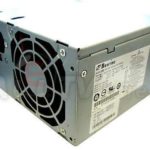Power supplies are the most overlooked component on any computer. However, in many ways, it is the most critical part of the entire machine. Without enough power to the components, even the most capable system on Earth will behave poorly, if even boot.
For me, my OEM 250 Watt power supply (a Lite-On 5251-08) just wasn’t cutting it: the system would run, but components were overheating (see my previous posts about video card issues). I eventually decided to go ahead and do an upgrade I had never done before: A power supply change out.
I learned quickly, from friends, the details of power supply voltage rails, and current ratings. That is when the thought hit me: how was my old power supply even running the video card? It simply should not be providing enough power. Then, suddenly, it all made sense; if the power supply is giving all it can, then the components might actually work, but very poorly, as they would not be getting their proper current flow. Thus, fans would not run as fast, and heat would build up quicker than it should. I had to upgrade.. there really was no other choice to the situation. I needed more power.
So, the first thing I had to do was research. I had to first learn the specifications I was working with on my current power supply, figure out the actual basic power amount I needed with the current hardware, and then finally see what was available that would fit the physical limits of my case.
In checking a website a friend linked to, I found out my systems power draw was somewhere around 350-400 Watts, at max. So, a 400 Watt power supply was the baseline I needed. Conveniently, I was able to find at Best Buy a power supply matching my case specifications perfectly; The Dynex 400W power supply.
Then came the actual installation. Now, while changing out a power supply sounds scary, it is actually a pretty straightforward procedure. Simply unplug all the cables from the motherboard and other devices, unscrew the suply from the case, and physically remove the power supply itself. Do the reverse for the new power supply, and things should be good. Plug it in, turn the system on, and it should boot without issue.
Upon booting my machine, I noticed about 10 degree lower idle temperatures, and overall better thermal performance from the video card: it seems my system is getting enough power to get the job done, finally. For some reason, the card still sometimes runs hot, but I believe this is due to some bugs in the way Firefox and YouTube make use of the video card for rendering. I will have to do more research into it.


![8311052_rb[1]](https://www.xadara.com/wp-content/uploads/2011/12/8311052_rb1-150x150.jpg)